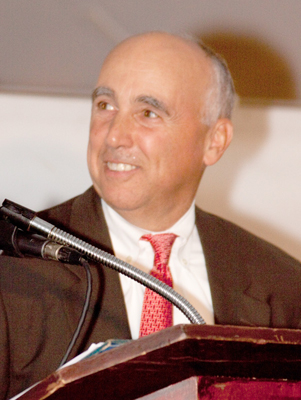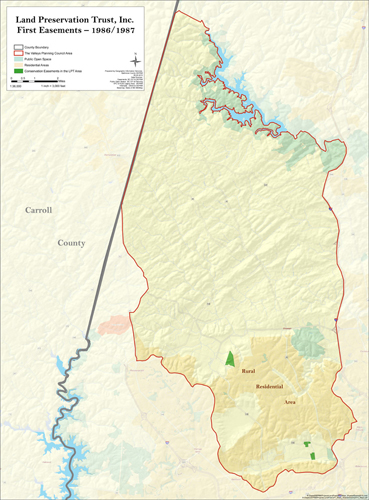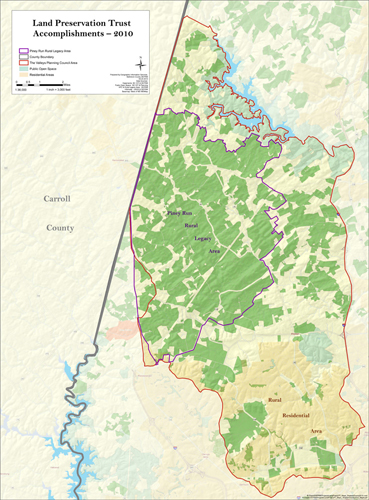Celebrating 28,000 Conserved Acres
Many thanks to Michael D. Hankin, president of the Land Preservation Trust, Inc. and Charles Fenwick Jr., executive director of Shawan Downs, Inc., for their contributions to this article.
On Thursday, September 23, 2010, the Legacy Chase at Shawan Downs celebrated its 10th anniversary, but the evening was about more than just the Legacy Chase; it was about the legacy of land conservation in Northern Baltimore County, which began with an unrealized vision in the 1960s and today includes over 28,000 preserved acres.
Shawan Downs is owned by the Land Preservation Trust (LPT), a 501c3 organization that was formed in 1986 to work alongside the Valleys Planning Council (see sidebar)
Walking the Walk: The LPT
While VPC is an important advocacy body, it was believed by residents of the Worthington and Greenspring Valleys that there was a role for a companion organization, which could actually take title to properties from time to time if necessary to facilitate a conservation mission, so they created the Land Preservation Trust.
Today, LPT engages in two primary activities: obtaining conservation easements and the ownership and operation of Shawan Downs.
Shawan Downs: Baltimore’s Gateway to Rural Conservation

The Signing of the Shawan-Manor Conservancy Agreement: Charlie Fenwick, Jr. for Shawan Downs, Jimmy Constable (signing) for the Manor Conservancy, and Mike Hankin for Land Preservation Trust. © Bob Keller
According to Shawan Downs’ Executive Director, Charlie Fenwick, Jr., twenty members of the community, led by Pedie Killebrew, pooled their resources thirteen years ago to acquire Shawan Downs for LPT. Since then, over 175 people have given at least $10,000 each for the development of Shawan Downs as an equestrian facility.
Today, most equestrians know Shawan Downs as the site for the Legacy Chase steeplechase race meet and for horse trials run by the Maryland Combined Training Association, but this 300-acre facility, along with the new Baltimore County Ag Center, demarcates where development ends and conservation begins in northern Baltimore County. From this location, fanning out west and north, one can see a living testament to the success a community can have when it collectively decides to conserve land.
Of the approximately 58,000 acres in the area bordered by Shawan and Tufton Roads on the south, Mt. Carmel Road on the north, Rt. 30 on the west, and I-83 on the east, 28,890 acres, or 50 percent, are under some form of conservation easement [see map]. Entities holding the easements include the Maryland Environmental Trust (see article elsewhere in this issue), Maryland Ag Land Preservation Foundation (see equiery.com/archives for more on MALPF), Baltimore County and the Land Preservation Trust. LPT alone holds easements on 10,662 acres.
In recent years, the most successful program has been the State Rural Legacy program, which provides funds to local land trusts, including the LPT, to purchase easements from landowners. This project has been especially successful with farmers.
To date, the state has granted $24,450,000 to LPT to acquire easements on 5,085 acres with an additional 267 acres in process. This amounts to 10% of the total amount that the state has paid out in Rural Legacy funds.
| It Began With a Vision
Before there was Shawan Downs, before there was the Land Preservation Trust, there was the Valleys Planning Council. |
It Takes A Village
This success is due to the efforts of many people, including the visionaries in the early 1960s who wrote the plan for the valleys; those pioneers who first took the chance, placing their farms in easement programs in the late 1970s and early 1980s (since then, over 350 landowners have participated in conservation easement programs); and those leaders in county government who committed to creative zoning, such as the one-for-fifty-acre zoning created in 1979 and the down-zoning of RC-5 land in 1996, both of which helped to set the right zoning “backdrop” for success with conservation easements.
With the establishment of the LPT, landowners had a vehicle through which conservation easements could be acquired. Mike Hankin sums up the routine: “When a property goes on the market for sale, a group of neighbors would get together, buy the land, put easements on the land, benefit from the tax deductions, and then sell the land.”
It Takes A Leader
While it is critical to have a supportive community, it nonetheless takes the energy, enthusiasm and tenacity of one or two individuals to turn visions and dreams into reality. Without the leader who can coordinate and harness the good intentions, without the leader who will relentlessly and tirelessly pursue obtaining the conservation easements from various landowners, we would not have over 28,000 acres now in conservation.
Ned Halle moved to northern Baltimore County in 1975, first becoming involved with conservation activities when he joined the board of VPC in 1992. Today, Ned runs the conservation easement operations of LPT and has been directly involved with placing easements on over 18,000 acres. Explains Mike Hankin, Ned “looks at the properties, one at a time, and figures out some way to persuade the property owner to place a conservation easement on his or her farm. He is perhaps best known for his ‘deals,’ those efforts to acquire properties under development pressure and take them off of the market.”

While running the conservation easement operations of LPT, Ned Halle has been directly involved with placing over 18,000 acres into easements. © Bob Keller
At the September 23 event celebrating Shawan’s anniversary, some of Ned’s more notable successes were discussed, places with which all local foxhunters should be familiar, including Buzzard’s Rock, the Speedway, Western Run, Caples. “The results have been huge, explains Mike. “These five deals alone have eliminated the potential [of] nearly 100 additional homes!”
The Future
Despite having been acquired thirteen years ago by the Land Preservation Trust, and despite being the gateway to conservation in northern Baltimore County, Shawan Downs itself had not been placed into any conservation program. As a facility hosting high-profile public events but which also maintains rural and agricultural activities, Shawan faced the challenge of finding the right type of program for its easements. After much searching for the right fit, the Land Preservation Trust finally found one, and on September 23 in a signing ceremony at the anniversary party, The Manor Conservancy obtained the easements to Shawan Downs.
In the meantime, in order to ensure the long-term financial stability of Shawan Downs, an endowment fund was established at the Legacy Chase anniversary party with the gift of $100,000 from the Charles T. Bauer Foundation.
A Look at the Shawan Downs area from 1986 to 2010


The dark green areas represent the conservation easements in the LPT area. The red border is The Valleys Planning Council Area and the purple border (map on right only) is the Pine Run Rural Legacy Area.
©TheEquiery2010









